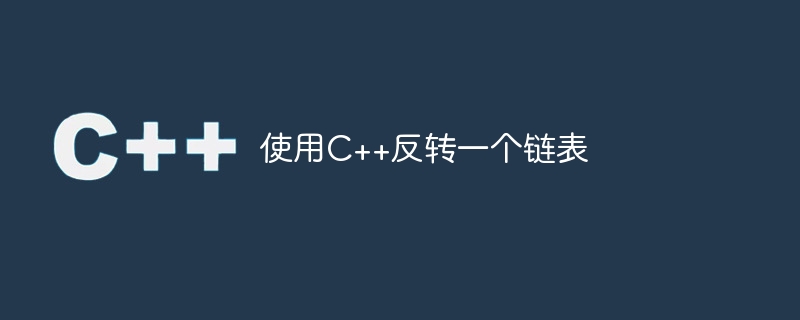使用C++反转一个链表

在这篇文章中,我们需要借助单链表来反转链接。我们的任务是创建一个能够反转给定单链表的函数。例如
Input: Following Linked list : 1->2->3->4->NULL Output: After processing of our function: 4->3->2->1->NULL
寻找解决方案的方法
有不同的方法来反转一个链表。通常,我们会想到一种简单的方法,即在遍历链表时将其反转。
简单方法
在这种方法中,我们将遍历链表并在遍历过程中尝试将其反转。
示例
#include<bits/stdc++.h>
using namespace std;
struct Node {
int data;
struct Node* next;
Node(int data) {
this->data = data;
next = NULL;
}
};
struct LinkedList {
Node* head;
LinkedList() { head = NULL; }
// Function to print linked list
void reverse() {
auto curr = head; // current pointer
Node* prev = NULL; // previous pointer
while(curr) {
auto temp = curr -> next;
curr -> next = prev;
prev = curr;
head = prev;
curr = temp;
}
}
void print() {
struct Node* temp = head;
while (temp != NULL) {
cout << temp->data << " ";
temp = temp->next;
}
}
void push(int data) {
Node* temp = new Node(data);
temp->next = head;
head = temp;
}
};
int main() {
LinkedList list;
list.push(20);
list.push(4);
list.push(15);
list.push(85);
list.print();
list.reverse();
cout << "\n";
list.print();
}输出
85 15 4 20 20 4 15 85
在这种方法中,我们只是遍历列表并在遍历过程中进行反转。这是一个很好的方法,因为时间复杂度为O(N),其中N是我们列表的大小。
现在我们尝试做一个实验,尝试使用堆栈来反转列表。
使用堆栈的方法
我们将使用一个堆栈来存储此程序中的所有节点,并通过遍历堆栈来反转它们。
示例
#include<bits/stdc++.h>
using namespace std;
struct Node {
int data;
struct Node* next;
Node(int data) {
this->data = data;
next = NULL;
}
};
struct LinkedList {
Node* head;
LinkedList() { head = NULL; }
// Function to print linked list
void reverse() {
auto curr = head; // current pointer
Node* prev = NULL; // previous pointer
stack<Node *> s;
while(curr) {
s.push(curr);
curr = curr -> next;
}
prev = s.top();
head = prev;
s.pop();
while(!s.empty()) {
auto temp = s.top();
s.pop();
prev -> next = temp;
prev = temp;
}
prev -> next = NULL;
}
void print() {
struct Node* temp = head;
while (temp != NULL) {
cout << temp->data << " ";
temp = temp->next;
}
}
void push(int data) {
Node* temp = new Node(data);
temp->next = head;
head = temp;
}
};
int main() {
LinkedList list;
list.push(20);
list.push(4);
list.push(15);
list.push(85);
list.print();
list.reverse();
cout << "\n";
list.print();
}
输出
85 15 4 20 20 4 15 85
上述代码的解释
在这种方法中,我们在遍历列表时将列表节点存储在堆栈中,然后使用堆栈将它们弹出并反转列表;这种方法的时间复杂度也为O(N),其中N是我们的列表大小。与之前一样,我们使用了堆栈,所以我们也可以使用递归方法,因为递归也使用了堆栈,现在我们将使用递归方法。
递归方法
在这种方法中,我们将执行与之前相同的过程,但使用递归调用。
示例
#include<bits/stdc++.h>
using namespace std;
struct Node {
int data;
struct Node* next;
Node(int data) {
this->data = data;
next = NULL;
}
};
struct LinkedList {
Node* head;
LinkedList() { head = NULL; }
// Function to print linked list
void rreverse(Node *curr, Node *prev) {
if(curr == NULL) {
// prev -> next = curr;
head = prev;
return;
}
rreverse(curr -> next, curr);
curr -> next = prev;
prev -> next = NULL;
}
void reverse() {
auto curr = head; // current pointer
Node* prev = NULL; // previous pointer
rreverse(curr -> next, curr);
}
void print() {
struct Node* temp = head;
while (temp != NULL) {
cout << temp->data << " ";
temp = temp->next;
}
}
void push(int data) {
Node* temp = new Node(data);
temp->next = head;
head = temp;
}
};
int main() {
LinkedList list;
list.push(20);
list.push(4);
list.push(15);
list.push(85);
list.print();
list.reverse();
cout << "\n";
list.print();
}输出
85 15 4 20 20 4 15 85
在这种方法中,我们与之前一样,但是使用递归调用,因此这种方法的时间复杂度也是O(N),其中N是我们列表的大小。
结论
在本文中,我们解决了反转单链表的问题。我们还学习了解决这个问题的C++程序和完整的方法(普通方法和其他两种方法)。我们可以用其他语言(如C、Java、Python和其他语言)编写相同的程序。希望您会觉得这篇文章有帮助。
以上是使用C++反转一个链表的详细内容。更多信息请关注PHP中文网其他相关文章!

热AI工具

Undresser.AI Undress
人工智能驱动的应用程序,用于创建逼真的裸体照片

AI Clothes Remover
用于从照片中去除衣服的在线人工智能工具。

Undress AI Tool
免费脱衣服图片

Clothoff.io
AI脱衣机

Video Face Swap
使用我们完全免费的人工智能换脸工具轻松在任何视频中换脸!

热门文章

热工具

记事本++7.3.1
好用且免费的代码编辑器

SublimeText3汉化版
中文版,非常好用

禅工作室 13.0.1
功能强大的PHP集成开发环境

Dreamweaver CS6
视觉化网页开发工具

SublimeText3 Mac版
神级代码编辑软件(SublimeText3)
 使用C++编写代码,找到第N个非平方数
Aug 30, 2023 pm 10:41 PM
使用C++编写代码,找到第N个非平方数
Aug 30, 2023 pm 10:41 PM
我们都知道不是任何数字的平方的数字,如2、3、5、7、8等。非平方数有N个,不可能知道每个数字。因此,在本文中,我们将解释有关无平方数或非平方数的所有内容,以及在C++中查找第N个非平方数的方法。第N个非平方数如果一个数是整数的平方,则该数被称为完全平方数。完全平方数的一些例子是-1issquareof14issquareof29issquareof316issquareof425issquareof5如果一个数不是任何整数的平方,则该数被称为非平方数。例如,前15个非平方数是-2,3,5,6,
 使用C++编写的数组右旋转的反转算法
Sep 08, 2023 pm 08:17 PM
使用C++编写的数组右旋转的反转算法
Sep 08, 2023 pm 08:17 PM
在本文中,我们将了解逆转算法,将给定的数组向右旋转k个元素,例如−Input:arr[]={4,6,2,6,43,7,3,7},k=4Output:{43,7,3,7,4,6,2,6}Explanation:Rotatingeachelementofarrayby4-elementtotherightgives{43,7,3,7,4,6,2,6}.Input:arr[]={8,5,8,2,1,4,9,3},k=3Output:{4,9,3,8,5,8,2,1}寻找解决方案的方
 在C编程中,找到一个圆的面积
Aug 25, 2023 pm 10:57 PM
在C编程中,找到一个圆的面积
Aug 25, 2023 pm 10:57 PM
圆是封闭图形。圆上的所有点到圆内一点的距离都相等。中心点称为圆心。点到圆心的距离称为半径。面积是封闭图形尺寸跨度的定量表示。圆的面积是圆的尺寸内包围的面积。计算圆面积的公式,Area=π*r*r为了计算面积,我们给出了圆的半径作为输入,我们将使用公式来计算面积,算法STEP1:Takeradiusasinputfromtheuserusingstdinput.STEP2:Calculatetheareaofcircleusing, area=(
 使用C++编写,找到前三个项为等差数列,后三个项为等比数列的四元组数量
Aug 30, 2023 pm 02:09 PM
使用C++编写,找到前三个项为等差数列,后三个项为等比数列的四元组数量
Aug 30, 2023 pm 02:09 PM
在本文中,我们将描述查找四元数的所有可能方法,其中前3项采用A.P.,后3项采用G.P.。首先,我们将解释算术级数(A.P.)和几何级数(G.P.)的基本定义。算术级数(A.P.)-它是一个数字序列,其中公差(d)相同或恒定,表示两个连续数字的差是恒定的。例如:1,3,5,7,9|d=2几何级数(G.P.)-这是一个数字序列,其中公共比率(r)相同,这意味着我们可以通过乘以前一个号码与固定号码。例如:3、6、12、24、....|r=2在这个问题中,我们需要确定N个整数的数组arr[]中有多少个
 使用C++编写代码,找到具有相同最小值和最大值的子数组的数量
Aug 25, 2023 pm 11:33 PM
使用C++编写代码,找到具有相同最小值和最大值的子数组的数量
Aug 25, 2023 pm 11:33 PM
在本文中,我们将使用C++解决寻找最大值和最小值相同的子数组数量的问题。以下是该问题的示例−Input:array={2,3,6,6,2,4,4,4}Output:12Explanation:{2},{3},{6},{6},{2},{4},{4},{4},{6,6},{4,4},{4,4}and{4,4,4}arethesubarrayswhichcanbeformedwithmaximumandminimumelementsame.Input:array={3,3,1,5,
 使用C++按给定大小将双向链表分组反转
Sep 04, 2023 am 09:49 AM
使用C++按给定大小将双向链表分组反转
Sep 04, 2023 am 09:49 AM
在这个问题中,我们得到一个指向链表头部的指针和一个整数k。在大小为k的组中,我们需要反转链表。例如-Input:1<->2<->3<->4<->5(doublylinkedlist),k=3Output:3<->2<->1<->5<->4寻找解决方案的方法在这个问题中,我们将制定一个递归算法来解决这个问题。在这种方法中,我们将使用递归并使用递归来解决问题。示例#include<iostream&
 使用C++找到数组中唯一配对的数量
Sep 07, 2023 am 11:53 AM
使用C++找到数组中唯一配对的数量
Sep 07, 2023 am 11:53 AM
我们需要适当的知识才能在C++的数组语法中创建几个唯一的对。在查找唯一对的数量时,我们计算给定数组中的所有唯一对,即可以形成所有可能的对,其中每个对应该是唯一的。例如-Input:array[]={5,5,9}Output:4Explanation:Thenumberofalluniquepairsare(5,5),(5,9),(9,5)and(9,9).Input:array[]={5,4,3,2,2}Output:16寻找解决方案的方法有两种方法可以解决这个问题,它们是−
 使用C++编写,找到一个集合上的自反关系的数量
Aug 26, 2023 pm 08:17 PM
使用C++编写,找到一个集合上的自反关系的数量
Aug 26, 2023 pm 08:17 PM
在本文中,我们将解释在一个集合上找到反身关系的方法。在这个问题中,我们给出一个数字n,以及一个由n个自然数组成的集合,我们必须确定反身关系的数量。反身关系-如果对于集合A中的每个'a',(a,a)属于关系R,则称关系R是集合A上的反身关系。例如-Input:x=1Output:1Explanation:set={1},reflexiverelationsonA*A:{{1}}Input:x=2Output:4Explanation:set={1,2},reflexiverelationsonA*






